ITALY IN SECRET TALKS TO EXIT WAR
Lisbon, Portugal · July 21, 1943
On this date in 1943 in Lisbon, delegates of Italian King Victor Emmanuel III met with the head of neutral Portugal to explore strategies for extracting Italy from the war. The Crown had begun searching for an exit as early as late 1942. After Allied landings in Axis-occupied North Africa in November 1942 (Operation Torch), the Italian high command approached the British via Switzerland the next month. With the approval of Fascist dictator Benito Mussolini (1883–1945), a third group comprising moderate Fascist party members proposed an armistice only to be rebuffed by the Allies before and again after the July 10, 1943, Allied landings in Italian Sicily (Operation Husky).
Four days after the Grand Council of Fascism in Rome had stripped Il Duce (Italian, “the leader”) of his power to govern (July 25, 1943), the new administration of Marshal Pietro Badoglio, who had been involved in earlier peace feelers, succeeded in negotiating an armistice, the so-called Short Armistice, signed in Sicily on September 3, 1943, and publicized by the Allies on September 8, a day before the main Allied assault on mainland Italy at Salerno (Operation Avalanche). Additional conditions demanded by the British directed Badoglio’s administration to hand over Mussolini, in Italian custody, along with other high-ranking Fascists suspected of having committed war crimes, to the forces of the “United Nations.” The conditions were spelled out at the time of the September 3 signing, but the Long Armistice, as it became known, was only signed on September 29 on the Mediterranean island of Malta. (The “Long Armistice” was pushed by Britain to humiliate Italy for having declared war on the British Empire.)
In between the two signings, German commandos under Waffen-SS Captain Otto Skorzeny engineered a high-risk glider rescue that sprang a suicidal Mussolini from house arrest in the Hotel Campo Imperatore on Gran Sasso mountain, high in Italy’s Apennines, on September 12, 1943. It was a propaganda coup for the Nazis, who flew Mussolini to meet Hitler at his Rastenburg headquarters in East Prussia, the Wolfsschanze, then back to German-occupied Northern Italy, where the Duce was installed as puppet ruler of a second (and last) incarnation of a Fascist Italian state, the Repubblica Sociale Italiana (Italian Social Republic), informally known as the Salò Republic, named after its capital.
[amazon_carousel widget_type=”ASINList” width=”600″ height=”200″ title=”Recommended Reading” market_place=”US” shuffle_products=”False” show_border=”False” asin=”0306815052,1929631421,080508861X,0230606059,1846034620,041573410X,076034034X,1589790952,1842121235,1844860590″ /]
High-Stakes Rescue of Imprisoned Italian Dictator Benito Mussolini, September 12, 1943
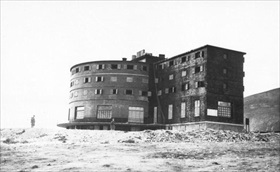 | 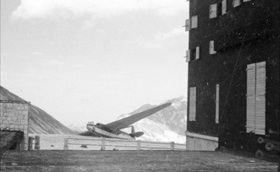 |
Left: The isolated alpine ski resort Campo Imperatore Hotel in 1943, where deposed dictator Benito Mussolini was eventually incarcerated. Mussolini’s Axis partner, Adolf Hitler, claimed that he would not let “Italy’s greatest son” down in his hour of need. His “old ally and dear friend” had to be rescued. The rescue was the last of Hitler’s spectacular gambles to bear fruit.
![]()
Right: German commandos under Waffen-SS Captain Otto Skorzeny crash-landed their nine gliders onto the hotel’s boulder-strewn slopes, then overwhelmed Mussolini’s stunned guards without a single shot being fired. Skorzeny formally greeted Mussolini, saying, “Duce, the Fuehrer has sent me to set you free!” to which Mussolini replied, “I knew that my friend would not forsake me!”
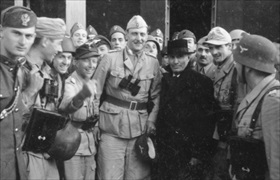 | 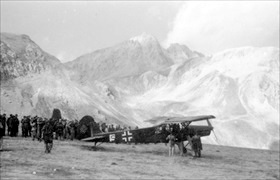 |
Left: Otto Skorzeny (center, dangling binoculars), field commander for Operation Oak (Unternehmen Eiche) with the liberated Mussolini, September 12, 1943. The high-risk operation saved Mussolini from being turned over to the Allies under the terms of the armistice and catapulted the talented commando leader to worldwide fame. Skorzeny received a promotion to Sturmbannfuehrer, a Nazi Party paramilitary rank equivalent to major, and was awarded the Knight’s Cross of the Iron Cross.
![]()
Right: From prior reconnaissance of the site, Skorzeny knew that only a light aircraft with short takeoff and landing capabilities had a chance of getting Mussolini off the mountain, so it was decided to land a Fieseler Storch (“Stork”) spotter plane on the uneven plateau. On takeoff with Mussolini, Skorzeny, and the pilot on board, the Storch toppled over the edge of the mountain into the valley below. A hundred feet from its doom on the valley floor, the aircraft corrected itself. Mussolini transferred to a larger Heinkel and was eventually flown to the Hitler’s East Prussia headquarters.
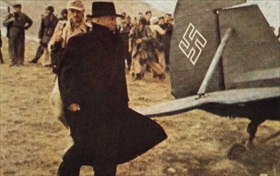 | 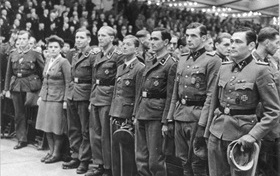 |
Left: Mussolini departed the Campo Imperatore Hotel for the Storch wearing a heavy coat and heavy ski boots. His rescue was one of the most famous commando operations of war, and it shocked the Allies. Eleven days after his rescue, Mussolini returned to German-occupied Italy, where he was installed as the titular head of the puppet Salò Republic.
![]()
Right: Skorzeny’s successful exploit produced a rare late-war public relations blip to sagging Axis fortunes, for it keep at least the appearance that Italy was still in the war on the Axis side. On October 3, 1943, Nazi Germany’s Thanksgiving Day, Berliners gathered in the Sport Palace to cheer the brave glider-borne raiding party that had extracted the deposed dictator from the hands of his enemies.
German Newsreel Account of Mussolini’s Dramatic Rescue, September 1943 (in German)
![]()

 History buffs, there is good news! The Daily Chronicles of World War II is now available as an ebook for $4.99 on Amazon.com. Containing a year’s worth of dated entries from this website, the ebook brings the story of this tumultuous era to life in a compelling, authoritative, and succinct manner. Featuring inventive navigation aids, the ebook enables readers to instantly move forward or backward by month and date to different dated entries. Simple and elegant! Click
History buffs, there is good news! The Daily Chronicles of World War II is now available as an ebook for $4.99 on Amazon.com. Containing a year’s worth of dated entries from this website, the ebook brings the story of this tumultuous era to life in a compelling, authoritative, and succinct manner. Featuring inventive navigation aids, the ebook enables readers to instantly move forward or backward by month and date to different dated entries. Simple and elegant! Click 











